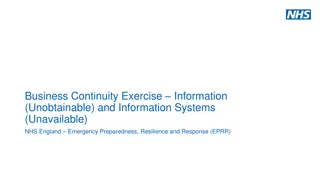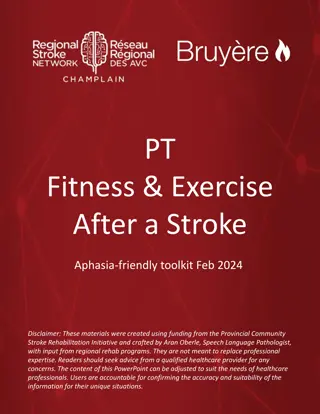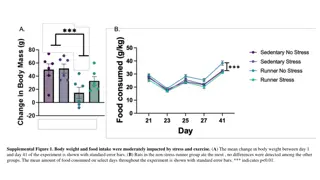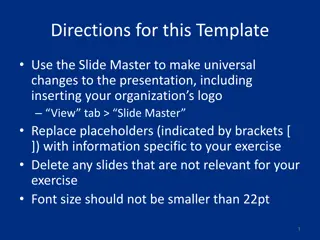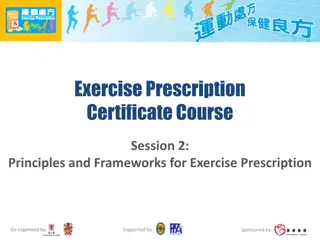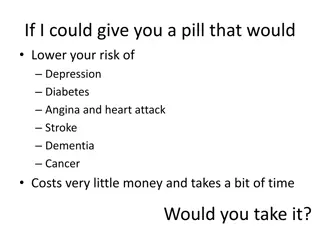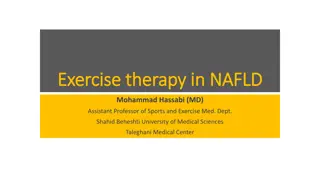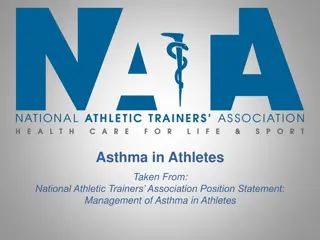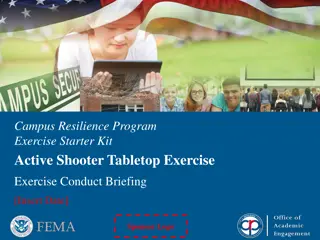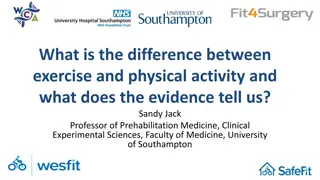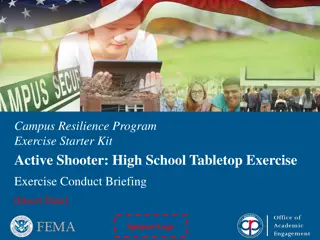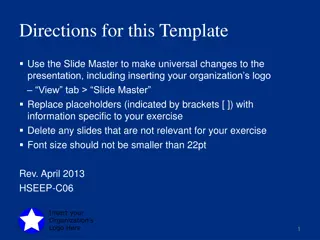Understanding the Importance of Warm-Up in Exercise
Explore the significance of warm-up exercises in preparing the body for physical activity, including components like joint mobility, muscle activation, and cardio-respiratory readiness. Learn about the R-A-M-P approach for effective warm-up routines, focusing on raising body temperature, activating muscle groups, mobilizing joints, and potentiation exercises. Engage in discussions on the purpose and benefits of warming up in group settings.
Download Presentation

Please find below an Image/Link to download the presentation.
The content on the website is provided AS IS for your information and personal use only. It may not be sold, licensed, or shared on other websites without obtaining consent from the author. Download presentation by click this link. If you encounter any issues during the download, it is possible that the publisher has removed the file from their server.
E N D
Presentation Transcript
Unit 10: Physical Activity for Individual and Group-Based Exercise BTEC Level 3 (RQF) Sport and Exercise Science 2020-21
Task B Task B Learning Aims: Learning Aims:
Learning Outcomes: Identify a variety of components that must be considered to perform exercises safely. Explain a variety of components that must be considered to perform exercises safely. Analyse a variety of components that must be considered to perform exercises safely.
The Warm up What is a warm up? What is the purpose of a warm up? (physiology) Discuss and feedback
The Warm Up (Jeffreys, 2006) A warm up provides a smooth transition from resting state to a state of athletic readiness (Crossley, 2012; pp. 26) Involves a period of preparation which includes activities for: - Joints (mobility) - Muscle Groups (activation) - Cardio-respiratory system - CNS
The R-A-M-P Approach (Jeffreys, 2006) Raise elevate core body temperature, heart rate, joint viscosity Activate activate key muscle groups and muscle fibre types (e.g. Type 11x in a long-jump warm up) Mobilise mobilise key joints and ranges of motion used in the sport (e.g. Overhead squats for the snatch) Potentiation increasing the intensity of exercise to a point that athletes are able to perform at their maximal levels often referred to as PAP https://www.atletiekunie.nl/sites/default/files/userfiles/thema/themadagen/loo ptrainersdag/2018/Handouts/Plyometrie%20Artikel%202%20- %20Nout%20van%20der%20Velden.pdf
R a i s e
What is the purpose of warming up? Discuss as a group (use MS Teams chat) To reduce the risk of musculoskeletal injury To improve performance as a whole Increased neural readiness speed and force of muscle contraction and activation Increase core body temperature Other physiological responses?
General Components of a Warm Up Pulse Raiser - 5 minutes with incremental increase in intensity - Raise core body temperature/respiratory rate - Can be monitored using RPE/MHR% - Intensity is dependent on athlete s ability
Pre-Stretches The type of stretch will depend on the activity/sport E.g. ballistic stretching may be used for explosive movement patterns such as javelin/discuss What type of stretches might be used in a warm up for your sport? Why?
Types of Stretches Types of Stretches BALLISTIC STRETCHING STATIC STRETCHING - MOMENTUM GENERATED BY USING A BOUNCING MOTION - CONTROLLED AND SLOW MOVEMENTS WHICH ELONGATE THE MUSCLES TO PROVIDE ELASTICITY. - It is important to implement stretches that are relevant to the physiological demands of the sport - USED TO ACTIVE FAST-TWITCH FIBRES TO FACILITATE EXPLOSIVE MOVEMENT - HIGH RISK, HIGH REWARD - PREVENT MUSCLE SORENESS - HOLD FOR 20-30 SECONDS - Always consider the athlete s current abilities (e.g. previous injuries) DYNAMIC STRETCHING PNF STRETCHING - How can you make the stretches sports-specific? ACTIVE STRETCHES WHEREBY JOINTS GO THROUGH FULL RANGE OF MOTION. - STRETCH IS FACILITATED - ASSISTED STRETCHING OFTEN REQUIRES A PARTNER OFTEN MIMIC THE ACTIVITY YOU RE ABOUT TO PERFORM - CONTRACT-RELAX-CONTRACT TECHNIQUE PASSIVE! INVOLVE MOVEMENT E.G. LEG SWINGS
Why Stretch? Preparation stretches: - Reduce the risk of injury - Increase performance Post-Activity Stretches: - Eliminate waste products - Reactivate neuromuscular responses - Release muscle tension
Key Term: Key Term: Delayed Onset Muscle Soreness (DOMS) Stress on connective muscle tissue (micro tears) Muscle stiffness/pain generally occurs 12- 72 hours after exercise Has a relationship with the recovery phase of training supercompensation occurs Cool downs play a key role in reducing DOMS.
Implementing a Cool- Down (Crossley, 2012) Provides a steady physiological transition from a working state back to a resting state. Should consist of a general cardiovascular element (e.g. slow jog) which slowly decreases in intensity (HR Decreases) Benefits: Possible reduction of DOMS (typically felt 24-48 hours after training) Improved removal of metabolic waste products after exercise (e.g. lactic acid) Passive Active
Practical Session Next Week: In groups of 2/3, plan the following: 10 minute warm up activity for a sport of your choice 10 minute cool down activity for a sport of your choice You will deliver this to your peers. Each group will feedback to those that have delivered. Please use the resources provided in the lesson!


